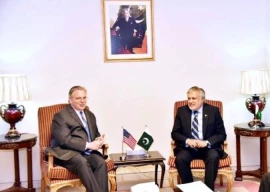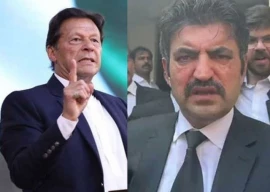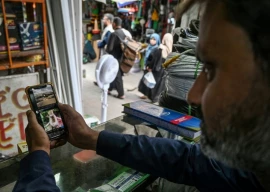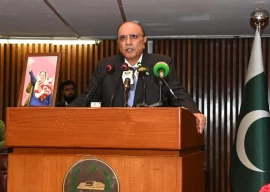
US Secretary of State Hillary Clinton has changed the sharp edge of her country’s policy for a more conciliatory stance towards Pakistan’s apparent aggressive response to demands that it attack North Waziristan and oust the Haqqani network from there. Instead, she has proposed in Islamabad that Pakistan facilitate American peace talks with the two kinds of Taliban (Pakistani and Afghan) and the Haqqani network, saying America had no evidence that Pakistan’s ISI was hand in glove with the Haqqanis or that the ISI had encouraged them to attack US-Nato targets in Afghanistan.
This is a significant change of attitude and Clinton’s powerful delegation stood guarantee to it: Director CIA General David Petraeus, Special US Representative for Afghanistan and Pakistan Marc Grossman, US Ambassador to Pakistan Cameron Munter, US Chairman Joint Chiefs of Staff General Martin Dempsey and Assistant to the President and Deputy National Security Adviser Lt-General Edward Lute who oversaw the killing of Osama bin Laden in Abbottabad. Is it an admission that the former policy was a misstep that Washington is now trying to correct or is it a measured and flexible response to Pakistan’s clearly desperate challenge on the basis of ‘strategic depth’ against a perceived ‘two-front’ situation?
It is clearly the latter rather than the former. Pakistan’s worry about India’s incursion into Afghanistan after a ‘strategic accord’ with Kabul has not been publicly addressed unless by getting the Taliban to talk the secretary said, gives Pakistan leverage against a pro-India government in Kabul. Other aspects of the Pakistan-US cleavage also remain, albeit in a lower profile. Clinton insisted that Pakistan take action within “days and weeks” to dismantle alleged terrorist sanctuaries on its soil, warning that a failure to do so would have devastating consequences for all concerned. This can be taken to mean that drone attacks will resume at a higher intensity.
Allowing Pakistan to be the intermediary in America’s talks with the Taliban and the Haqqani network looks like a concession but may in fact be a burden that Pakistan’s own contradictory approach to terrorism might render unbearable. Can the ISI get the various brands of terrorists to agree to even begin talking? The record says that despite spending a lot of wealth on them and despite smearing its reputation as a peaceful state while dealing with the Taliban, no dent was ever made with the ‘warriors’ who don’t talk when they think they have the upper hand; also on the evidence accumulated so far, these terrorists tend to not really betray their sworn loyalties, even when someone from among them appears to engage in peace talks. There is also evidence that the Taliban are simply incapable of normal governance if they are given stakes in the running of a state.
Headlines saying America eats the humble pie in the face of the Pakistan Army’s resolute stance in the ‘national interest’ should be avoided. There are still some irreducible hurdles in the way in the shape of India’s perceived growing presence in Afghanistan and Pakistan’s inflexible approach to handling India’s move now that it has been made. There is a thick underbrush of incomprehensible Taliban ‘conditionalities’ attached to talks; there are also Pakistan’s own tough conditionalities which it will attach to the Taliban’s demands while preparing the ground for US-Taliban talks.
American conditions — “they must lay down arms, abide by the Afghan constitution and respect basic human rights, especially women’s rights” — may prove to be too tough to negotiate. The only way Pakistan can get the terrorists to agree is to get them to feel weak. This cannot happen unless Pakistan overcomes its internal vulnerabilities — including a takeover by the terrorists — and is able to inflict a clear military defeat on them. Today, the dilemma in Pakistan is whether it is India that is the enemy as described in our faded textbooks or al Qaeda and its minion, the Taliban. Therein lies the hidden strength of America’s latest change of tack with Pakistan.
Published in The Express Tribune, October 23rd, 2011.
COMMENTS (4)
Comments are moderated and generally will be posted if they are on-topic and not abusive.
For more information, please see our Comments FAQ


















































Interesting! Mr Feroz, just how did u reach to this conclusion about haqqani net work? If the US pays Haqqani group "bhatta " for allowing their transport and logistics a safe passage and for their engineers to work on the development projects then why cannot we have some relations with them? U must differentiate between the sordid policies of the CIA sponsored US establishment which in turn itself is heavily Ziion loaded and the gentle and helpful average americans who are even more simple than proverbial sikhs (no offence meant). US govt offers us the right hand while trying to stab with the left. It only does to those countries for she has no respect - and who would respect a nation with the sleazy leaders , uneducated and self serving that we have. And as an end note we have a strong suspicion that the so called pakistani talibans are a product of CIA -with strong relations with India- who has given them the technique for brain washing as well. Young brain washed lads create the law and order noise - so that the investment stay away from Pakistan and vector towards India.
regs am
Today the Pakistani people believe that US is the threat not India. From the editorial it seems that the Media is as confused as the Establishment about what Foreign policy to pursue. It should have been very clear by now that the Foreign policy followed by the country for 64 years has been a disaster. More of the same will be a bigger disaster. If the wise heads think that Haqqani and the Taliban will act as allies and extended arms once they are a part of the Government in Kabul, this dream will be shattered fast.
strong textIn my opinion the Afghani Government should set new elections and the Taliban should participate too.
In case the population of Afganistan votes for them,they should occupy some sits in the Parlaiment.
After all,they were fighting for the sovereinty of their country.If the Afghani or Pakistani Armees marched on JF Kennedy Blvd.in washinghton,DC,the Americans would have killed all foreign troops or probably by now gased them all.
The Americans should understand,that they are not wanted NOWHERE!
Why after all US is pressing for Haqqani who controls only a segment of Afghanistan - about 20% - the rest 80%- how do US plan to neutralize that? And, on a more inquisitive note why after all the US needs to be in Afghanistan after the death of Osama? Talibans had no role in 9/11- so why punish them? Why does the US not look over her back yard where numerous countries need to be civilized, need education , the streets are full of rogue elements,poverty abounds;dictators have a field day, and woman are treated like a scum. am